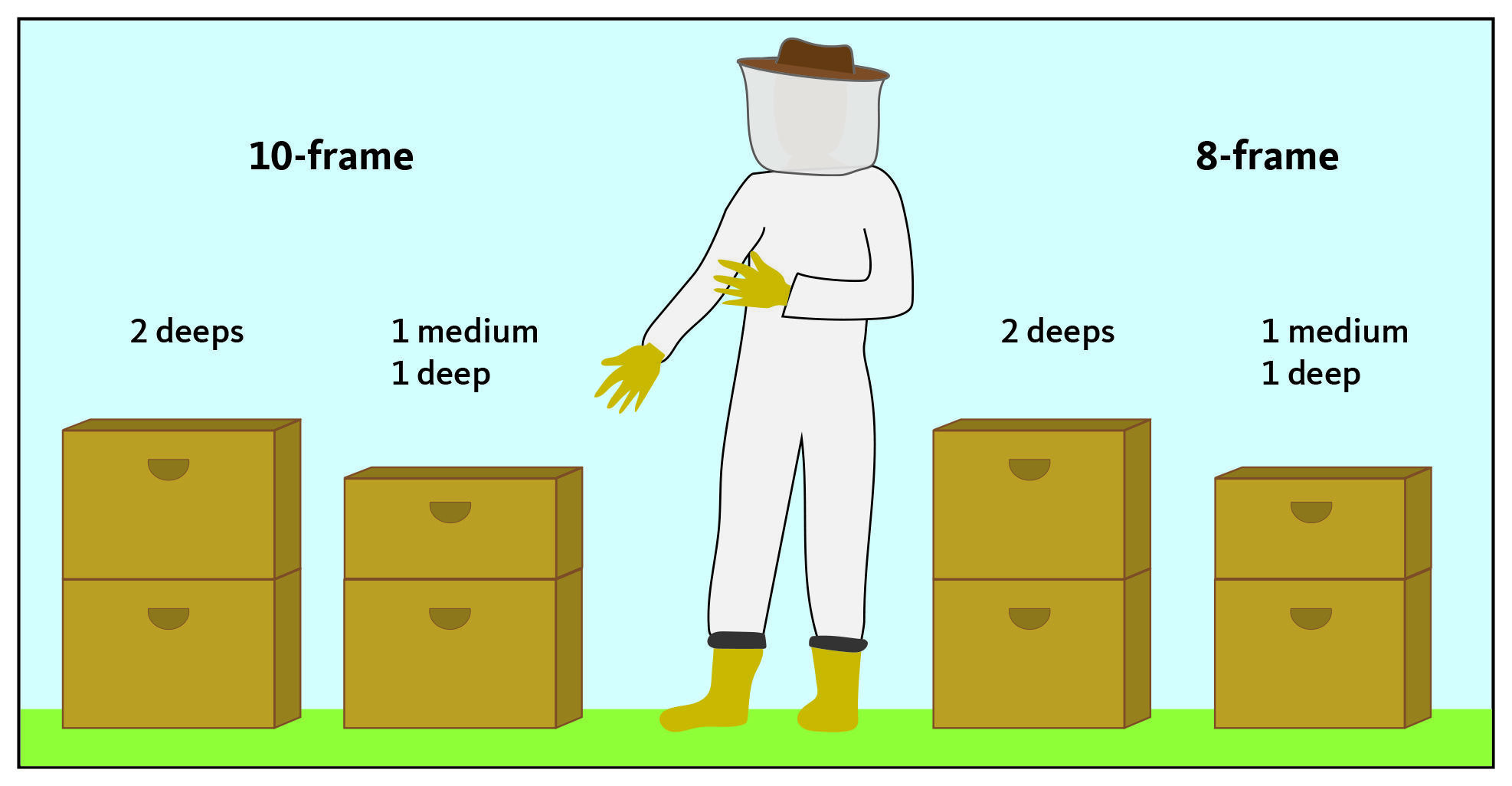Introduction
Woodenware for a typical honey bee colony includes vertically stackable boxes with removable frames, bottom board, lid and queen excluder. The most common design is Langstroth equipment. Langstroth colony configuration varies widely among beekeepers but is generally standardized within an operation for ease of transport, storage and management.
Colony configuration
Beekeepers in the Pacific Northwest commonly have two boxes for the brood chamber and two to five boxes for surplus honey. Brood chambers are usually two different-sized boxes called deeps (height: 9 5/8 inches) and mediums (height: 6 5/8 inches), also called Dadant, Illinois or western. The main colony configurations are two deeps or one medium and one deep box (Figure 1, page 2).
The honey supers are usually one size: either mediums or deeps. Beekeeping operations use either 10-frame (width: 16 1/4 inches) or 8-frame (width: 14 inches) equipment. Many beekeepers like the reduced weight and cost of 8-frame equipment. However, more 8-frame boxes may be required to provide adequate space to the colony than with 10-frame equipment. The narrower 8-frame colony may allow more colonies to be placed on a flatbed or semi-truck. In recent years, the trend among small-scale beekeepers is to use three mediums as the brood chamber. This results in higher per-colony costs for woodenware (Table 1).
Table 1: Average cost of woodenware for 100 colonies with three different Langstroth colony configurations: two deeps, one deep and one medium and three mediums*
|
Two deeps |
One medium, one deep |
Three mediums |
|
|
10-frame |
$8,808 |
$8,368 |
$11,316 |
|
8-frame |
$7,798 |
$7,480 |
$9,945 |
Sources: Betterbee (Greenwich, New York), Dadant & Sons, Inc. (Hamilton, Illinois), GloryBee Foods, Inc. (Eugene, Oregon), Mann Lake Ltd. (Hackensack, Minnesota), True Wood Products (Addy, Washington), Western Bee Supplies, Inc. (Polson, Montana).
*This table shows the differences in woodenware costs. The table includes woodenware components only for colonies on pallets: two brood boxes, assembled wooden frames with plastic foundation and a migratory lid. Colony configurations vary greatly and may include feeders in place of frames, have preexisting comb, or other differences.
Woodenware and other hive components
There are many factors that influence the cost of hive equipment. These include woodenware quality, bulk purchase discounts and freight costs. In addition to the boxes, each colony requires the proper frames, base (or pallet), lid, feeder and an optional queen excluder. Equipment can be manufactured with basic woodworking equipment or purchased from other beekeepers, beekeeping supply companies or specialty retailers.
Frames are either plastic or wooden with a wax-coated plastic foundation. Frames vary in price (Table 2, page 3). It is common to have a 1-gallon internal or external feeder for each colony. Painted woodenware has a lifespan of about 10 years. Woodenware suppliers may have slightly different dimensions for their hive boxes, so check measurements before purchasing equipment from several different suppliers.
Table 2. Average and range of purchase cost for unassembled commercial-grade woodenware and accessory items in a palletized colony system*
|
Equipment |
Type |
Average cost |
Cost range |
|
Brood and honey boxes |
|||
|
Deep |
10-frame |
$13.18 |
$10.50–$14.95 |
|
8-frame |
$13.33 |
$10.50–$15.95 |
|
|
Medium |
10-frame |
$9.78 |
$7.50–$11.70 |
|
8-frame |
$10.15 |
$7.50–$13.50 |
|
|
Frames |
|||
|
Wooden, assembled |
Deep |
$2.51 |
$2.15–$2.65 |
|
Medium |
$2.41 |
$2.05–$2.55 |
|
|
Wooden, unassembled, plastic foundation |
Deep |
$2.23 |
$2.01–$2.46 |
|
Medium |
$1.78 |
$1.15–$2.09 |
|
|
Plastic |
Deep |
$2.31 |
$2.02–$3.02 |
|
Medium |
$2.04 |
$1.68–$2.67 |
|
|
Feeder |
|||
|
Internal |
1 gallon |
$7.14 |
$4.30–$8.95 |
|
External |
1 gallon |
$7.44 |
$4.50–$12.95 |
|
Lids |
|||
|
Migratory |
10-frame |
$11.52 |
$7.65–$13.00 |
|
8-frame |
$11.16 |
$7.65–$13.00 |
|
|
Pallet |
|||
|
Pallet |
Used, with clips |
$20.75 |
$15.00–$28.00 |
|
Pallet straps |
2 straps ($/pallet) |
$6.58 |
$6.50–$8.00 |
|
Queen excluders |
|||
|
Metal |
10-frame |
$6.25 |
$5.95–$6.85 |
|
8-frame |
$6.12 |
$5.65–$6.75 |
|
|
Plastic |
10-frame |
$2.96 |
$2.60–$3.20 |
|
8-frame |
$3.05 |
$2.90–$3.20 |
|
Sources: Betterbee (Greenwich, New York), Dadant & Sons, Inc. (Hamilton, Illinois), GloryBee Foods, Inc. (Eugene, Oregon), Mann Lake Ltd. (Hackensack, Minnesota), True Wood Products (Addy, Washington), Western Bee Supplies, Inc. (Polson, Montana).
*Listed bulk prices are in 100-unit increments for boxes, lids, feeders and queen excluders and 500-unit increments for frames. Cost of paint and assembly labor not included.
Further reading
Beekeeping woodenware equipment
Ellis, J. 2014. The Langstroth hive. American Bee Journal, 154(3): 257–260.
Ellis, J.D., W.H. Kern and C.M. Zettel Nalen. 2016, University of Florida, Institute of Food and Agricultural Sciences Extension Service. Preserving Woodenware in Beekeeping Operations. Publication No. ENY125. edis.ifas.ufl.edu/aa244
Beekeeping business plan guides
Daily, S., S. Jacobson, S. Kohler and J. Buchhelt. 2003. Beekeeping Business Plan Workbook.
Mussen, E. University of California, Division of Agriculture and Natural Resources. 1994. Starting a Small Beekeeping Operation.
Payne, S. 2016. Strategic Business Planning. Bee Culture.
Providence of British Columbia, Minister of Agriculture, Fisheries and Food. Preparing a business plan: a guide for agricultural producers beekeeper example. www2.gov.bc.ca/gov/content/industry/agriculture-seafood/animals-and-crops/animal-production/bees
Sanford, M. University of Florida, Florida Cooperative Extension Service. December 1992. A Study in Profitability for a Mid-Sized Beekeeping Operation. Fact Sheet No. RF-AA089. ufdcimages.uflib.ufl.edu/UF/00/07/71/22/00001/AA08900.PDF
References
Ellis, J. 2014. The Langstroth hive. American Bee Journal, 154(3): 257–260.
Sammataro D. and A. Avitabile. 2011. The Beekeeper’s Handbook (4th ed.). Ithaca, NY, Cornell University Press: 308 pp.
Wenning, C.J. 2012. Getting into Beekeeping: Counting the Costs.
Project supported by National Institute of Food and Agriculture Smith Lever Special Needs Competitive Grants Program (Award# 2018-41210-28702).
About this series
In this series, Budgeting for a Commercial Beekeeping Operation in the Pacific Northwest, we describe potential revenue streams and expenditures associated with a commercial beekeeping operation. This publication does not discuss depreciation, interest, taxes, insurance costs or enterprise budgets. Refer to the “Further reading” section for detailed beekeeping business plan guides.
Included in this series:
- Fact Sheet 1: Revenue Sources for a Commercial Beekeeping Operation in the Pacific Northwest
- Fact Sheet 2: Operational Equipment Expenses for a Commercial Beekeeping Operation in the Pacific Northwest
- Fact Sheet 3: Beekeeping Equipment Expenses: Woodenware and Other Components
- Fact Sheet 4: Honey Bee Colony Maintenance Expenses: Supplemental Feed, Requeening and Medication
This publication will be made available in an accessible alternative format upon request. Please contact [email protected] or 1-800-561-6719. © 2020 Oregon State University. Extension work is a cooperative program of Oregon State University, the U.S. Department of Agriculture, and Oregon counties. Oregon State University Extension Service offers educational programs, activities, and materials without discrimination on the basis of race, color, national origin, religion, sex, gender identity (including gender expression), sexual orientation, disability, age, marital status, familial/parental status, income derived from a public assistance program, political beliefs, genetic information, veteran’s status, reprisal or retaliation for prior civil rights activity. (Not all prohibited bases apply to all programs.) Oregon State University Extension Service is an AA/EOE/Veterans/Disabled.
Published May 2020
© 2020 Oregon State University.




